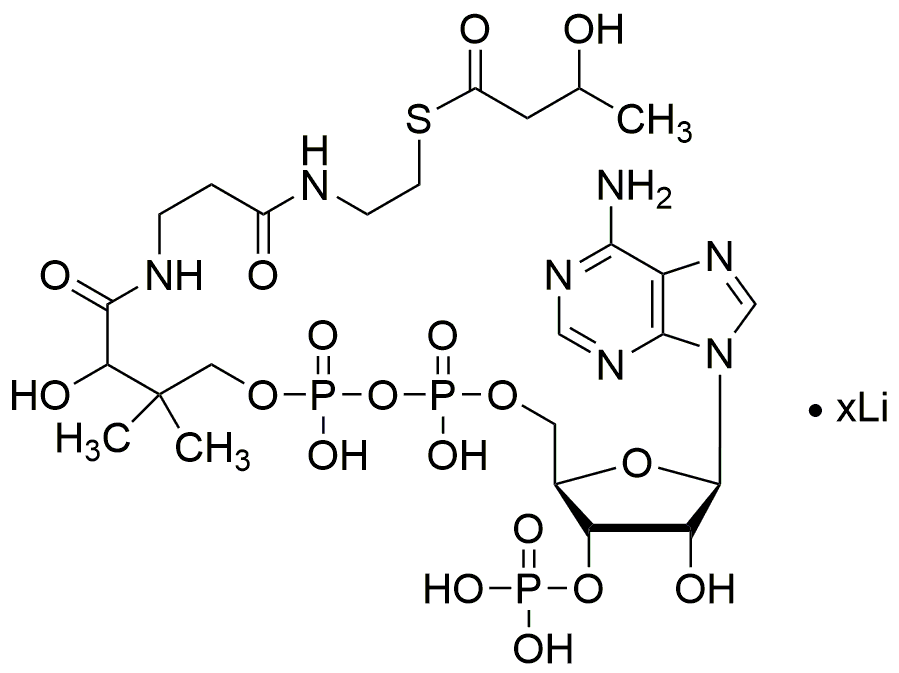DL-b-Hydroxybutyryl coenzyme A lithium salt is widely utilized in research focused on:
- Metabolic Studies: This compound plays a crucial role in studying metabolic pathways, particularly in understanding energy production and fat metabolism in cells.
- Pharmaceutical Development: It is used in the development of drugs targeting metabolic disorders, helping researchers design therapies for conditions like obesity and diabetes.
- Biochemical Assays: The compound serves as a substrate in various biochemical assays, allowing scientists to measure enzyme activity and understand metabolic processes.
- Cell Culture Applications: It is utilized in cell culture media to support the growth of specific cell types, enhancing research in cellular biology and tissue engineering.
- Research on Neurodegenerative Diseases: The compound is being explored for its potential effects on neuronal metabolism, providing insights into diseases like Alzheimer's and Parkinson's.
Informations générales
Propriétés
Sécurité et réglementation
Applications
DL-b-Hydroxybutyryl coenzyme A lithium salt is widely utilized in research focused on:
- Metabolic Studies: This compound plays a crucial role in studying metabolic pathways, particularly in understanding energy production and fat metabolism in cells.
- Pharmaceutical Development: It is used in the development of drugs targeting metabolic disorders, helping researchers design therapies for conditions like obesity and diabetes.
- Biochemical Assays: The compound serves as a substrate in various biochemical assays, allowing scientists to measure enzyme activity and understand metabolic processes.
- Cell Culture Applications: It is utilized in cell culture media to support the growth of specific cell types, enhancing research in cellular biology and tissue engineering.
- Research on Neurodegenerative Diseases: The compound is being explored for its potential effects on neuronal metabolism, providing insights into diseases like Alzheimer's and Parkinson's.
Documents
Fiches de données de sécurité (FDS)
La FDS fournit des informations de sécurité complètes sur la manipulation, le stockage et l’élimination du produit.
Spécifications du produit (PS)
Le PS fournit une description complète des propriétés du produit, notamment sa composition chimique, son état physique, sa pureté et les exigences de stockage. Il détaille également les plages de qualité acceptables et les applications prévues du produit.
Certificats d'analyse (COA)
Recherchez des certificats d'analyse (COA) en saisissant le numéro de lot du produit. Les numéros de lot et de lot se trouvent sur l'étiquette d'un produit, après les mots « Lot » ou « Lot de fabrication ».
Numéro de catalogue
Numéro de lot/série
Certificats d'origine (COO)
Ce certificat d'exploitation confirme le pays dans lequel le produit a été fabriqué, et détaille également les matériaux et composants utilisés et s'il est issu de sources naturelles, synthétiques ou autres sources spécifiques. Ce certificat peut être requis pour les douanes, le commerce et la conformité réglementaire.
Numéro de catalogue
Numéro de lot/série
Fiches de données de sécurité (FDS)
La FDS fournit des informations de sécurité complètes sur la manipulation, le stockage et l’élimination du produit.
DownloadSpécifications du produit (PS)
Le PS fournit une description complète des propriétés du produit, notamment sa composition chimique, son état physique, sa pureté et les exigences de stockage. Il détaille également les plages de qualité acceptables et les applications prévues du produit.
DownloadCertificats d'analyse (COA)
Recherchez des certificats d'analyse (COA) en saisissant le numéro de lot du produit. Les numéros de lot et de lot se trouvent sur l'étiquette d'un produit, après les mots « Lot » ou « Lot de fabrication ».
Numéro de catalogue
Numéro de lot/série
Certificats d'origine (COO)
Ce certificat d'exploitation confirme le pays dans lequel le produit a été fabriqué, et détaille également les matériaux et composants utilisés et s'il est issu de sources naturelles, synthétiques ou autres sources spécifiques. Ce certificat peut être requis pour les douanes, le commerce et la conformité réglementaire.


